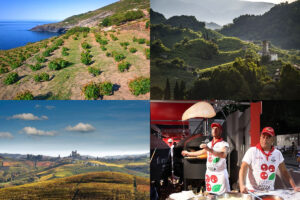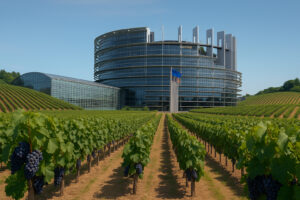A decade after the previous census, the sixth ISTAT, Italian national institute of statistics, Agriculture Census (temporary data) reveals a profoundly changed agricultural world. The number of farms has dropped dramatically and, today there are 1.630.420, 32.2% less than in 2000, for a total of 12.885.186 hectares of UAA - Utilized Agricultural Area. Agricultural areas dropped somewhat, too: 17.277.023 acres (8% less compared to 2000) and cultivated areas (2.3% less), but the average size of the farms has grown significantly, Istat data reveals - from 5.5 hectares UAA per farm in 2000 to 7.9 hectares in 2010 (+44.4%). Farms are bigger in size, “the condition that allows entrepreneurs to be competitive”, according to the Minister of Agriculture, Saverio Romano, but there are also more woman-owned businesses: from 30.4% in 2000 to 33.3% in 2010.
The distribution of UAA among the four groups of cultivations measured by the 2010 census is not much different than in 2000: farmland in 2010 covered 54.4% of UAA (compared to 55.3% in 2000) and the absolute value recorded a 3.7% decrease; permanent fields and pastures 26.9% (compared to 25.9% in 2000) marking an increase of 1.6%; UAA shares of agricultural woody cultivations (18.4% of the total, compared to 18.5% in 2000) and family vegetable gardens (0.2% versus 0.3% in 2000) are almost unchanged, though they both decreased in absolute value, respectively 3% and 23.9%. There are extreme differences from region to region: the average size of farms in Sardinia is 19.2 hectares of utilized agricultural area while in Liguria it is 2.1 hectares per farm. Puglia boasts the largest number of farms - 275.000, followed by Sicily, Calabria, Campania and Veneto: these are the 5 regions where 54.6% of Italian farms are located.
Who are the agriculture workers? 2.5 million people were employed in farming and livestock breeding in the 2009-2010 agricultural year, a sharp decline from 2000 (31.6% less). In 2010, among agricultural workers there was a trend to shift the workload from family run companies to employees with either open-ended or fixed-term work contracts (called “other company workforce”). The latter workforce increased from 18.6% to 21.5%, while family run workforce dropped from 81.4% to 78.5%. Farm business managers are younger and younger: the average age now is 55-59 while in 2000 it was 60-64 years old. This confirms the trend of people under 30 working in the agriculture world, which increased from 2.1% to 2.5%. Managers under 45 also increased from 18.2% in 2000 to 18.6% in 2010. This rejuvenation means higher education: 60% of CEOs have at least a junior high school diploma (in 2000 it was only 40%), and University graduates represent 6.4% of the total workforce (3.5% in 2000). Romano says, “It is a significant sign of a generational change that is promising for the future”.
Focus - Comments: “8% of farm businesses manages 63% of farmland,” points out Confagricoltura; Coldiretti underlines that the number of University graduates has doubled “we need to use these results to build a new development project”, says CIA “8% of the businesses manage 63% of the farmland, consolidating a minority driving force. Production concentration in the last ten years has meant that 132.000 companies, each operating on at least 20 hectares of land, manage nearly 8 million out of the total 13 million hectares”. Giandomenico Consalvo, member of the Board of Confagricoltura, points out the temporary results of the sixth ISTAT Census of Agriculture “over the past ten years there has been a drop in farms with 20 or fewer UAA hectares. Instead, farms with more than 20 hectares have increased in number and in hectares. Today, a little less than 10% of the total number of farms is more than 20 hectares in size and they manage nearly two-thirds of the national UAA. Smaller farms with less than 20 hectares of UAA decreased in number but represent more than 90% of the companies and manage 37% of utilized agricultural area”.
Consalvo adds “Istat attributes the evolution process both to the dynamics of the market as well as the effect of EU policies. We agree on the first motive because strong competitive pressure has led to strengthening productive units. The second aspect needs a more thorough explanation because decoupling of direct aid, paid independently from production, does not necessarily encourage business competitiveness”. “In Brussels”, concludes Consalvo, “more needs to be done about structural policies for business competitiveness and overall supply which we expect from the new reform of the Common Agricultural Policy towards 2020”.
Commenting these data, the President of Coldiretti, the Association of Italian Farmers, Sergio Marini, emphasizes instead how “over the past 10 years University graduates have more than doubled at the head of farm businesses. This confirms a professional process which has affected the increase in the average size of companies by 44.4% and above all, the extraordinary growth of farmers engaged in multi-functional processing activities, selling products and offering innovative services”.
Marini adds, “The average company size increase to 7.9 acres is the result of reorganizing the business system, which led to the exit of marginal businesses (32.2% less). This operation has reduced utilized agricultural areas in Italy in the last 10 years by 2.3%, equal to 12.8 million hectares in 2010. It is important to stress,” continues Marini, “that the vast majority of the 6.6% of University graduate farm managers attended faculties other than agriculture, which demonstrates how the sector has expanded its areas of operation”. Finally, Marini concludes, “the new census data comes exactly 10 years after the framework law (No. 228 of May 18, 2001), strongly supported by Coldiretti, widened the boundaries of agriculture and effectively revolutionized farm business activity in the Italian countryside by opening to new employment opportunities. Farmers can now manage activities ranging from transformation of products to sales in the company or on farmers markets (the first direct sales network managed by the farmers has been created), as well as providing services to private and public administrations. Not to mention the production and sale of beer made from barley grown on the farm or bread from the wheat, or cosmetics based on wine, oil or donkey milk. And also, educational farms affiliated with schools, agri-kindergartens and agri-homes”.
CIA-Confederation of Italian farmers, maintains, “The general impression is that agriculture is irreversibly leaving behind a certain structural inertia. The process is not painless, though, since positive phenomena such as the expansion in size of agricultural enterprises are the result of a sharp decline in the number of active companies. In 10 years, more than 775.000 units (32.2% less) have gone off the market, especially among SMEs”. Moreover, the fact that the number of companies has decreased while the utilized agricultural area has remained the same, “means that companies are beginning to merge into larger units, which is now indispensable in order to be competitive on international markets. But, we need to make an extra effort to reach the European average (12 hectares compared to 7.9 hectares in Italy)”.
According to CIA, “we also need to accelerate the process of consolidating land, which is still slow despite the “boom” of leased (+52.4%) or free loan for use land (+76.6%)”. CIA points out, “these tentative signs of change are up against, however, a strong negative aspect: there is no trace of generational change in the Census. To date, in fact, CEOs under 30 manage only 2.5% of farms. Ten years ago the percentage was 2.1%. This is very poor growth and further proof that so far little or nothing has been done to foster and encourage young people into the sector, despite the repeated appeals of our Confederation. That is why now, in light of the ISTAT study, we must work to build a new agricultural policy - concludes the CIA - using the results of the Census as a reference and reminder that it is necessary to create a new development plan for the sector. The occasion could be the next General State of Agriculture meetings, called by Minister Romano in November”.
Copyright © 2000/2025
Contatti: info@winenews.it
Seguici anche su Twitter: @WineNewsIt
Seguici anche su Facebook: @winenewsit
Questo articolo è tratto dall'archivio di WineNews - Tutti i diritti riservati - Copyright © 2000/2025








































































































































































































